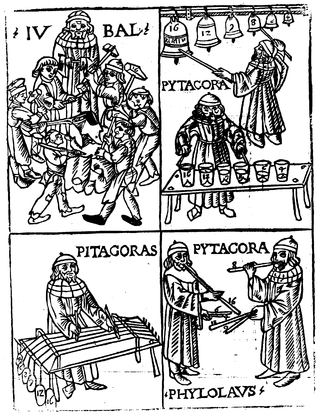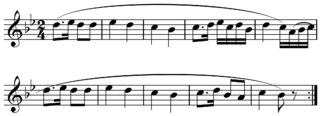
Atonality in its broadest sense is music that lacks a tonal center, or key. Atonality, in this sense, usually describes compositions written from about the early 20th-century to the present day, where a hierarchy of harmonies focusing on a single, central triad is not used, and the notes of the chromatic scale function independently of one another. More narrowly, the term atonality describes music that does not conform to the system of tonal hierarchies that characterized European classical music between the seventeenth and nineteenth centuries. "The repertory of atonal music is characterized by the occurrence of pitches in novel combinations, as well as by the occurrence of familiar pitch combinations in unfamiliar environments".

Music theory is the study of the practices and possibilities of music. The Oxford Companion to Music describes three interrelated uses of the term "music theory": The first is the "rudiments", that are needed to understand music notation ; the second is learning scholars' views on music from antiquity to the present; the third is a sub-topic of musicology that "seeks to define processes and general principles in music". The musicological approach to theory differs from music analysis "in that it takes as its starting-point not the individual work or performance but the fundamental materials from which it is built."
Sonata form is a musical structure generally consisting of three main sections: an exposition, a development, and a recapitulation. It has been used widely since the middle of the 18th century.
In music, serialism is a method of composition using series of pitches, rhythms, dynamics, timbres or other musical elements. Serialism began primarily with Arnold Schoenberg's twelve-tone technique, though some of his contemporaries were also working to establish serialism as a form of post-tonal thinking. Twelve-tone technique orders the twelve notes of the chromatic scale, forming a row or series and providing a unifying basis for a composition's melody, harmony, structural progressions, and variations. Other types of serialism also work with sets, collections of objects, but not necessarily with fixed-order series, and extend the technique to other musical dimensions, such as duration, dynamics, and timbre.
Binary form is a musical form in 2 related sections, both of which are usually repeated. Binary is also a structure used to choreograph dance. In music this is usually performed as A-A-B-B.

The twelve-tone technique—also known as dodecaphony, twelve-tone serialism, and twelve-note composition—is a method of musical composition first devised by Austrian composer Josef Matthias Hauer, who published his "law of the twelve tones" in 1919. In 1923, Arnold Schoenberg (1874–1951) developed his own, better-known version of 12-tone technique, which became associated with the "Second Viennese School" composers, who were the primary users of the technique in the first decades of its existence. The technique is a means of ensuring that all 12 notes of the chromatic scale are sounded as often as one another in a piece of music while preventing the emphasis of any one note through the use of tone rows, orderings of the 12 pitch classes. All 12 notes are thus given more or less equal importance, and the music avoids being in a key. Over time, the technique increased greatly in popularity and eventually became widely influential on 20th-century composers. Many important composers who had originally not subscribed to or actively opposed the technique, such as Aaron Copland and Igor Stravinsky, eventually adopted it in their music.
In music, an ostinato is a motif or phrase that persistently repeats in the same musical voice, frequently in the same pitch. Well-known ostinato-based pieces include classical compositions such as Ravel's Boléro and the Carol of the Bells, and popular songs such as Donna Summer and Giorgio Moroder's "I Feel Love" (1977), Henry Mancini's theme from Peter Gunn (1959), The Who's "Baba O'Riley" (1971), and The Verve's "Bitter Sweet Symphony" (1997).
Erwin Ratz was an Austrian musicologist and music theorist. He is known especially for his work as president of the Gustav Mahler Gesellschaft and for his book Einführung in die musikalische Formenlehre. During Nazi rule, he saved the lives of several Austrian Jews by sheltering them in his apartment for a number of years.
In music, form refers to the structure of a musical composition or performance. In his book, Worlds of Music, Jeff Todd Titon suggests that a number of organizational elements may determine the formal structure of a piece of music, such as "the arrangement of musical units of rhythm, melody, and/or harmony that show repetition or variation, the arrangement of the instruments, or the way a symphonic piece is orchestrated", among other factors. It is, "the ways in which a composition is shaped to create a meaningful musical experience for the listener."
Form refers to the largest shape of the composition. Form in music is the result of the interaction of the four structural elements described above [sound, harmony, melody, rhythm]."
In Western musical theory, a cadence is the end of a phrase in which the melody or harmony creates a sense of full or partial resolution, especially in music of the 16th century onwards. A harmonic cadence is a progression of two or more chords that concludes a phrase, section, or piece of music. A rhythmic cadence is a characteristic rhythmic pattern that indicates the end of a phrase. A cadence can be labeled "weak" or "strong" depending on the impression of finality it gives. While cadences are usually classified by specific chord or melodic progressions, the use of such progressions does not necessarily constitute a cadence—there must be a sense of closure, as at the end of a phrase. Harmonic rhythm plays an important part in determining where a cadence occurs.

In music, a motif(pronunciation) (help·info) IPA: (/moʊˈtiːf/) is a short musical idea, a salient recurring figure, musical fragment or succession of notes that has some special importance in or is characteristic of a composition. The motif is the smallest structural unit possessing thematic identity.
In music, function is a term used to denote the relationship of a chord or a scale degree to a tonal centre. Two main theories of tonal functions exist today:

In music theory, a phrase is a unit of musical meter that has a complete musical sense of its own, built from figures, motifs, and cells, and combining to form melodies, periods and larger sections.
A phrase is a substantial musical thought, which ends with a musical punctuation called a cadence. Phrases are created in music through an interaction of melody, harmony, and rhythm.

In music, a subject is the material, usually a recognizable melody, upon which part or all of a composition is based. In forms other than the fugue, this may be known as the theme.

In music, the term period refers to certain types of recurrence in small-scale formal structure. In twentieth-century music scholarship, the term is usually used as defined by the Oxford Companion to Music: "a period consists of two phrases, antecedent and consequent, each of which begins with the same basic motif." Earlier usage varied somewhat, but usually referred to similar notions of symmetry, recurrence, and closure. The concept of a musical period originates in comparisons between music structure and rhetoric at least as early as the 16th century.
In music composition, fragmentation is the use of fragments or the "division of a musical idea into segments". It is used in tonal and atonal music, and is a common method of localized development and closure.
In musical composition, developing variation is a formal technique in which the concepts of development and variation are united in that variations are produced through the development of existing material.
William E. Caplin is an American music theorist who lives and works in Montreal, Quebec, Canada, where he is a James McGill Professor at the Schulich School of Music of McGill University. Caplin served as president of the Society for Music Theory from 2005 to 2007 and was its vice-president from 2001 to 2003. His earlier work concentrated on the history of music theory, but he is best known for a series of articles and two books on musical form in European music around 1800. The first of those books, Classical Form: A Theory of Formal Functions for the Music of Haydn, Mozart, and Beethoven has been widely influential and was a major factor in the revival of interest in musical form in North-American music theory.
Rudolph Reti, also Réti, was a musical analyst, composer and pianist. He was the older brother of the chess master Richard Réti, but unlike his brother, Reti did not write his surname with an acute accent on the 'e'.
Leonard Gilbert Ratner, was an American musicologist, Professor of Musicology at Stanford University, He was a specialist in the style of the Classical period, and best known as a developer of the concept of Topic theory.







